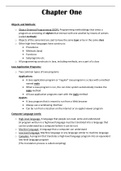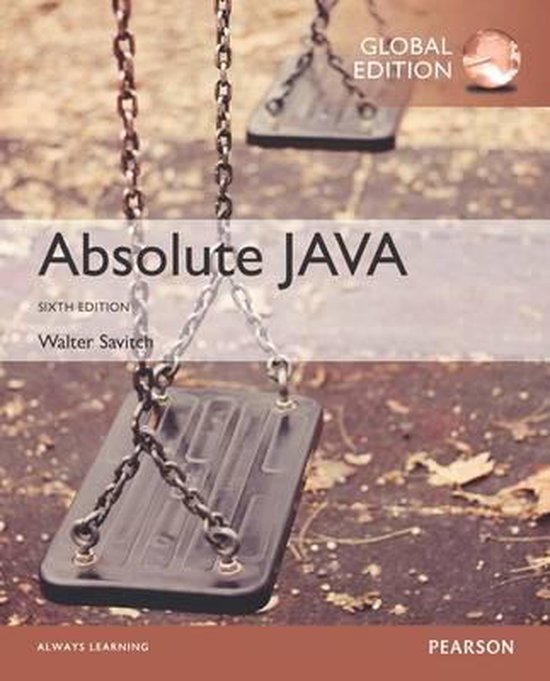Chapter One
Objects and Methods:
o Object-Oriented Programming (OOP): Programming methodology that views a
program as consisting of objects that interact with one another by means of actions
(called methods)
o Objects of the same kind are said to have the same type or be in the same class
o Other high-level languages have constructs:
• Procedures
• Methods (Java)
• Functions
• Subprograms etc.
o All programming constructs in Java, including methods, are a part of a class
Java Application Programs:
o Two common types of Java programs:
Applications
• A Java application program or “regular” Java program is a class with a method
named main
• When a Java program is run, the run-time system automatically invokes the
main method
• All Java application programs start with the main method
Applets
• A Java program that is meant to run from a Web browser
• Always use a windowing interface
• Can be run from a location on the internet or an applet viewer program
Computer Language Levels:
o High-level language: A language that people can read, write and understand
(A program written in a high-level language must be translated into a language that
can be understood by a computer before it can be run)
o Machine language: A language that a computer can understand
o Low-level language: Machine language or any language similar to machine language
o Compiler: A program that translates a high-level language program into an equivalent
low-level language program
(This translation process is called compiling)
,Byte-Code and Java Virtual Machine:
o Compilers for most programming languages translate high-level programs directly into
the machine language for a particular computer
o Since different computers have different machine languages, a different compiler is
needed for each one
o In contrast, the Java compiler translates Java programs into byte-code, a machine
language for a fictitious computer called the Java Virtual Machine
o Once compiled to byte-code, a Java program can be used on any computer, making it
portable
o Interpreter: Program that translates a program, written in Java byte-code, into the
machine language for a particular computer when a Java program is executed
o The interpreter translates and immediately executes each byte-code instruction
o Translating byte-code into machine code is relatively easy compared to the initial
compilation step
o Most Java programs run using a Just-In-Time (JIT) compiler which compiles a section of
byte-code, at a time, into machine code
Objects and Methods:
o Code: A program or a part of a program
o Source code: A program written in a high-level language such as Java, and the input to
the compiler program
o Object code: The translated low-level program and the output from the compiler
program (e.g. Java byte-code)
o In the case of Java byte-code, the object code is the input to the Java byte-code
interpreter
Class loader:
o Java programs are divided into smaller parts called classes
o Each class definition is in a separate file and compiled separately
o Class loader: A program that connects the byte-code of the classes needed to run a
Java program
o In other programming languages, the corresponding program is called a linker
Compiling a Java Program or Class:
o Each class definition must be in a file whose name is the same as the class name
followed by .java
o Each class is compiled with the command javac followed by the name of the file in
which the class resides
o This result is a byte-code program whose filename is the same as the class name
followed by .class
1.FirstProgram.java
2.javac FirstProgram.java
3.FirstProgram.class
,Running a Java Program:
o A Java program can be given the run command after all its classes have been compiled
o Only runs the class that contains the main method
(The system will automatically load and run the other classes, if any)
o The main method begins with the line:
public static void main(String[ ] args)
o Follow the run command by the name of the class only
Syntax and Semantics:
o Syntax: The arrangement of words and punctuations that are legal in a language
(grammar rules of a language)
o Semantics: The meaning of things written while following the syntax rules of a
language
Error Messages:
o Bug: A mistake in a program
o Debugging: The process of eliminating bugs
o Syntax error: A grammatical mistake in a program
(The compiler can detect these errors, and will output an error message saying what
and where it thinks the error is)
o Run-time error: An error that is not detected until a program is run
(The compiler cannot detect these errors - an error message is only generated after
execution)
o Logic error: A mistake in the underlying algorithm for a program
o (The compiler cannot detect these errors and no error message is generated)
System.out.println:
o Java programs work by having objects perform actions
o System.out: An object used for sending output to the screen
o The actions performed by an object are called methods
o println: The method or action that the System.out object performs
o Invoking/calling a method: When an object performs an action using a method
o Method invocation syntax (in order):
• An object
• A dot (period)
• Method name
• Pair of parentheses
o Arguments: Zero or more pieces of information needed by the method that are placed
inside the parentheses
Using = and +:
o The equal sign (=) is used as the assignment operator
e.g. answer = 2 + 2;
, o The plus sign (+) is used to denote addition or concatenation
(two strings can be connected together)
e.g. System.out.println("2 plus 2 is " + answer);
Identifiers:
o Identifier: The name of a variable or other item (class, method, object, etc.) defined in
a program
o Must not start with a digit
o All characters must be letters, digits, or the underscore symbol
o Theoretically can be of any length
o Java is a case-sensitive language:
Rate, rate, and RATE are the names of three different variables
o Keywords and Reserved words: Identifiers that have a predefined meaning in Java e.g.
public, class, void, static
o Predefined identifiers: Identifiers that are defined in libraries required by the Java
language standard e.g. System, String, println
Naming Conventions:
o Start the names of variables, classes, methods, and objects with a
lowercase/uppercase letter
o Indicate "word" boundaries with an uppercase letter
o Restrict the remaining characters to digits and lowercase letters
e.g. topSpeed, bankRatel, timeOfArrival, FirstProgram, MyClass
Variable declarations:
o Every variable in a Java program must be declared before it is used
o Tells the compiler what kind of data (type) will be stored in the variable
o Give the type of the variable followed by its name and a semicolon
o Variables are typically declared just before they are used or at the start of a block
(indicated by an opening bracket { )
o Basic types in Java are called primitive types:
e.g. int numberOfBeans;
double oneWeight, totalWeight;
Primitive types:
o Boolean
o Char
o Byte
o Short
o Int
o Long
o Float
o Double





